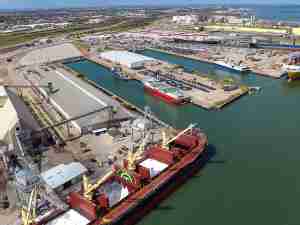The Maryland Department of Transportation Maryland Port Administration (MDOT MPA) is welcoming a new Asian container service through Southeast Asia/Vietnam and China with the launch of a new Maersk Line to the Helen Delich Bentley Port of Baltimore. This Transpacific/Panama Canal service will begin in July with the first ships arriving in Baltimore in late August. The service will include a string of up to 13 ships with carrying capacities of 4,500-plus Twenty-foot Equivalent (TEU) containers.
“This new service from Southeast Asia reflects the industry’s confidence in the Port of Baltimore and indicates how Maryland is in a great position to capture new business as the economy recovers,” said Governor Larry Hogan. “Our dedicated workforce and state-of-the-art infrastructure make the Port one of Maryland’s top economic engines.”
The new service will arrive at the Port’s Seagirt Marine Terminal, which is managed by Ports America Chesapeake under the public-private partnership with MDOT MPA. Vessels in Maersk’s new TP20 Loop service will originate in the Port of Vung Tao, Vietnam, head north to the ports of Ningbo-Zhoushan, China and Shanghai, China and then sail through the Panama Canal discharging goods in Norfolk and Baltimore – the only two U.S. ports in this service string.

The service reflects a need for more cargo gateways in the United States, as port congestion is at an all-time high. Baltimore is a prime gateway for containers with goods heading to the ecommerce market and for cargo sent to the Midwest via rail. The Port of Baltimore has a proven track record of handling mid-size container ships that will be utilized by Maersk in the new Southeast Asia service. The Port has served 22 “ad hoc” ships over the past year – vessels diverted to Baltimore that were not on a regularly scheduled service call – totaling more than 35,000 TEU.
“The new Maersk service will help commerce move through Maryland across the country and around the globe,” said MDOT MPA Executive Director William P. Doyle. “The Port of Baltimore’s incredible e-commerce abilities, combined with the number of local distribution, fulfillment and sorting centers, make us very attractive to beneficial cargo owners.”
“Ports America Chesapeake is excited to be expanding our partnership with Maersk as they introduce a new East Coast Trans-Pacific service calling Baltimore,” said Bayard Hogans, vice president of Ports America Chesapeake. “Maersk’s TP20 service will expand the global reach of the Port of Baltimore by providing direct ocean service to South East Asia, specifically Vietnam.”
“The new Maersk line is fantastic news for the men and women of ILA 333,” said Scott Cowan, president of International Longshoremen’s Association Local 333. “More business for the Port of Baltimore means more work for our labor force. We are also looking forward to increased work opportunities with the second deep container berth and when the Howard Street Tunnel project comes online.”
The Port’s container business is getting a lift with the ongoing project to expand capacity to serve ultra-large ships. Dredging is complete for a second, 50-foot-deep berth at the Seagirt Marine Terminal, and four additional Neo-Panamax cranes arriving this summer will be operational by the end of the year. Baltimore is one of a few East Coast ports with the ability to handle some of the world’s largest vessels, and the new deep berth will allow two of these massive ships to be serviced at the same time.
Complementing the new Seagirt berth are plans to expand Baltimore’s Howard Street Tunnel, which received final federal environment approval this month under the National Environmental Policy Act. The expanded tunnel will allow for double-stacked container rail cars, clearing a longtime hurdle for the Port and giving the East Coast seamless double-stack capacity from Maine to Florida. The project involves clearance improvements in the tunnel and at 22 other locations between Baltimore and Philadelphia.
The Howard Street Tunnel project benefits from public-private investment from the federal government, Maryland, CSX, and others, and is expected to increase the Port’s business by about 160,000 containers annually. It will also generate about 6,550 construction jobs and an additional 7,300 jobs from the increased business.
“As the worldwide economy recovers from the pandemic, the maritime industry has seen the Port of Baltimore’s leadership, reliability, and efficiency,” said MDOT Secretary Greg Slater. “The industry also has seen Maryland’s commitment to invest in Port infrastructure. Our Port is ready to serve the industry and consumers today, and will be a leader well into the future.”
“This new business will help us prime the pump well in advance of the Howard Street Tunnel project,” said Executive Director Doyle. “This will allow ocean carriers, non-vessel operating common carriers and freight forwarders to market Baltimore to Southeast Asia manufacturers.”
The Port has made a strong recovery since the early months of the COVID-19 pandemic, which greatly impacted the international maritime industry. In May, major cargos at the Port’s state-owned, public marine terminals were up significantly year-over-year, with autos up 146%, roll on/roll off farm and construction machinery up 62% and containers up 15% compared to May 2020. Total general cargo was up 35%.










